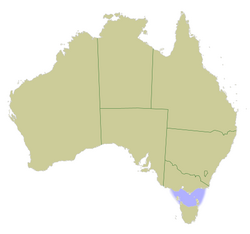Bass Strait Triangle
This article includes a list of general references, but it lacks sufficient corresponding inline citations. (April 2009) |

The Bass Strait Triangle is the waters that separate the states of Victoria and Tasmania, including Bass Strait, in south-eastern Australia. The term Bass Strait Triangle (inspired by the Bermuda Triangle) appears to have been first used[a] following the disappearance of Frederick Valentich in 1978 although the region had a bad reputation (never ascribed to supernatural forces, however) long before that.
Geography of Bass Strait
Bass Strait is a generally shallow (average depth of 50 m (160 ft)) stretch of water approximately 300 km (190 mi) wide and 200 km (120 mi) from north to south, encompassed by the entire northern coastline of Tasmania and Victoria's central to eastern coast. The prevailing winds and currents are westerly, the latter being divided by
All shipping to the busy ports of
Incidents
Bass Strait was discovered following the wreck of the ship
Actual north-south (and vice versa) crossing of Bass Strait seldom occurred until after Melbourne was established in 1835. From 1838-1840, at least seven vessels were lost with all hands on their way to or from the new settlement, wreckage from only three being identified. Rumours that some of these vessels had fallen victim to wreckers appear baseless, the main cause probably being bad weather and poor charts.
- In 1858, the British warship HMS Sappho disappeared, with well over one hundred lives lost, and no positively identifiable wreckage located.[4][5]
- In 1901 the SS Federal disappeared carrying coal from New South Wales with 31 crew. Her wreck was not located until 2019[6]
- In 1906 the SS Ferdinand Fischer, a German cargo ship, disappeared.
- The SS Amelia J, a schooner, disappeared on 10 September 1920. HMAS Swordsman was commissioned to search for the ship, and while searching the Bass Strait, a second ship - the barquentine SS Southern Cross - disappeared. A military Airco DH.9A engaged in the search would also then disappear.[7][8] Wreckage of the SS Southern Cross was found on King Island; the SS Amelia J was never discovered, and neither was the Airco DH.9A.[9]
- The De Havilland Express Miss Hobart, went missing soon after entering service in 1934, only a small amount of wreckage being found on the Victorian coast.
- In 1935 Loina, a Holyman airliner, crashed into the sea near Flinders Island with three crew and two passengers lost.[10] No bodies were found.[11] The cause of both accidents was probably a combination of human error with the known poor design of the aircraft.[12]
- During the RAAF Bristol Beaufort bombers — were lost during exercises in Bass Strait while on training flights out of air bases, mainly RAAF Base East Sale near Sale, Victoria. These accidents were probably caused by the inexperienced crew crashing into the sea while performing low-level bombing practice — similar accidents occurred over land.[13]
- In 1972 a De Havilland Tiger Moth flown by Brenda Hean and Max Price disappeared on a flight from Tasmania to Canberra as part of protests against the flooding of Lake Pedder for a hydroelectricity scheme.[14] It was believed to have crashed at sea somewhere between the East Coast and Flinders Island.[citation needed] Sabotage by pro-development interests was alleged.[15][page needed]
- In 1978 a Cessna flown by UFO.[16]
- 1979 the yacht Charleston disappeared while sailing to Sydney to join the Sydney-Hobart Yacht Race.[17]
References
- Notes
- ^ The term appears on the back cover of "The Devil's Meridian" by Kevin Killey & Gary Lester, published in 1980, and makes up part of the title of Jack Loney's book on the region published in the same year.
- ^ Australian Pilot Volume II: : South, South- East and East Coasts of Australia from Green Cape to Port Jackson Including Bass Strait and Tasmania. Somerset: Hydrographic Department. 1982.
- ISBN 978-0975133187.
- ISBN 978-0975133187.
- ^ Killey & Lester 1980, pp. 23 & 24
- ISBN 978-0975133187.
- ^ "Bass Strait shipwreck studied in bid to solve century-old mystery". www.abc.net.au. 27 June 2019.
- ^ Killey & Lester 1980, pp. 26–31
- ISBN 978-0992366001.
- ^ Royal Australian Navy. "HMAS Swordsman". www.navy.gov.au. Retrieved 28 July 2020.
- ^ Killey & Lester 1980, pp. 33–43
- ^ "GRIM EVIDENCE OF THE LOINA DISASTER". Examiner (Launceston, Tas. : 1900 - 1954). 4 October 1935. p. 7.
- ISBN 1-875671-11-0.
- ISBN 0-958797-84-6.
- ^ Killey & Lester 1980, pp. 49 & 50
- ^ Millwood 2008
- ^ "Search for pilot who saw UFO, then disappeared discontinued". Lodi News-Sentinel. United Press International. 1978-10-26. Retrieved 2021-04-26.
- ^ "Lost yacht mystery continues 30 years on". www.abc.net.au. 21 December 2009.
- Sources
- ISBN 0-7344-0338-0.
- Broxam, Graeme; Nash, Michael (2013). Tasmanian Shipwrecks, Volume 1 - 1797-1899. Canberra: Navarine Publishing. ISBN 978-0975133187.
- Broxam, Graeme; Nash, Michael (2013). Tasmanian Shipwrecks, Volume 2 - 1900-2012. Canberra: Navarine Publishing. ISBN 978-0992366001.
- Killey, Kevin; Lester, Gary (1980). The Devil's Meridian. Sydney: Lester-Townsend. ISBN 0-949853-01-1.
- ISBN 1-875671-11-0.
- ISBN 0-9091315-3-8.
- Millwood, Scott (2008). Whatever happened to Brenda Hean?. Crows Nest, NSW: Allen and Unwin. ISBN 978-1-74175-611-1.
- Whitmore, Debbie (1999). An Extreme Event:The compelling, true story of the tragic 1998 Sydney-Hobart Race. Sydney: Random House Australia. ISBN 0-0918-4057-0.
External links
- Australia Broadcasting Corporation: transcript of TV program on the disappearance of Brenda Hean and Max Price. http://www.abc.net.au/tv/rewind/txt/s1173814.htm
